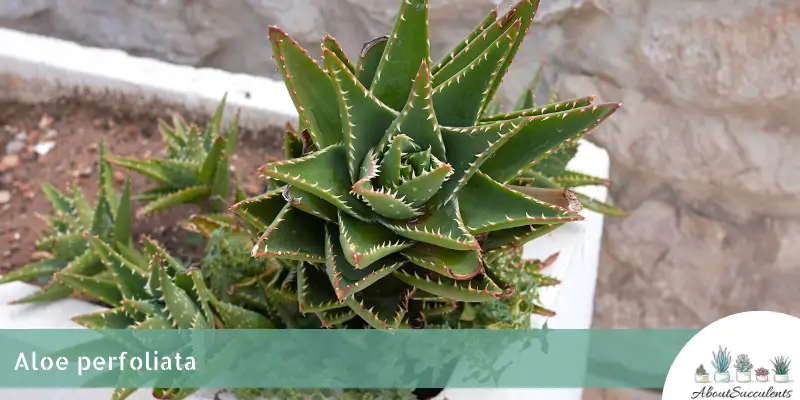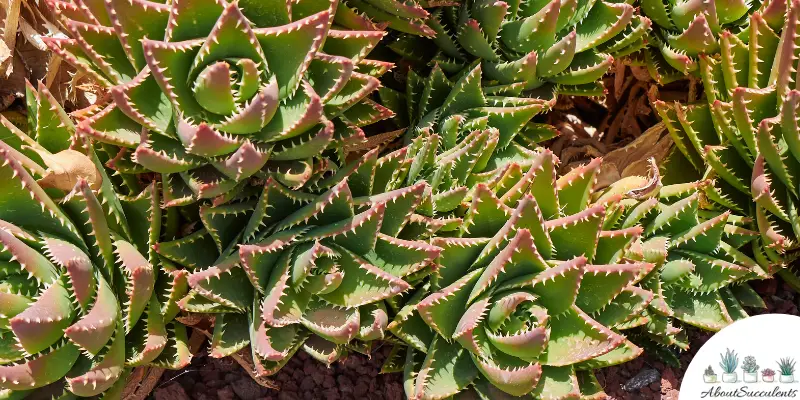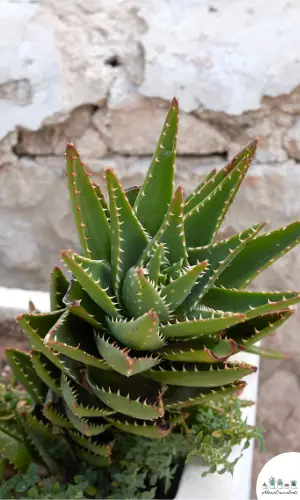
Aloe perfoliata, also known as ‘Mitre Aloe’ is an unusual-looking, hard creeping succulent that spreads out in small clusters of rosettes.
It has spear-shaped fleshy leaves that have soft white teeth on the margins and white bumps on the undersides. Aloe perfoliata grows up to 30.5cm (12”) tall and 61cm (24”) wide.
In its natural environment, Mitre Aloe grows recumbent and branched stems that can reach up to 2m (6ft) long. This succulent does not grow upright but instead sprawls along the grounds or rocks.
Aloe perfoliata that grows exposed to the full sun become adorned with tightly packed bluish leaves, while those plants that have thrived in shaded areas develop green widely spaced leaves.
During summer, Aloe perfoliata blooms red cone-shaped flowers that are attached to stalks which can grow up to 90 cm (35 in) tall.
Mitre Aloe originates from the mountainous areas of the Western Cape, South Africa. It’s part of the Aloe genus from the Asphodelaceae family.
General Information:
Also known as: Mitre Aloe
Plant Family: Asphodelaceae
Origin: Western Cape, South Africa
Height: 30.5cm (12”)
Exposure: Partial to Full Sun
Water Needs: Drought-resistant; use the ‘soak and dry’ watering method
Soil Type: Well-draining potting soil combined with plenty of gritty materials such as perlite or pumice
Soil pH: 6.5 – 7.5
How to Grow and Care for Aloe Perfoliata

You can easily grow Aloe perfoliata at home as the main feature in your outdoor rock garden or indoor container garden.
Aloes are not cold-hardy and cannot withstand temperatures below 10°C (50°F). They grow best at temperatures of 20°C – 30°C (68°F-86°F). If the temperature in your region plummets below these numbers, it would be better to plant Mitre Aloe is a pot that can be transferred indoors.
Sunlight
Outdoors, Aloe perfoliata grows well in an area exposed to morning full sun and afternoon partial shade and these alien-like succulents need 5 to 6 hours of sunlight.
The leaves will elongate and turn pale when the plant does not get adequate exposure to sunlight. Do not expose Mitre Aloe to the intense light of the afternoon sun as this will lead to sunburn.
As a houseplant, place your container in an area where it can get direct or partial morning sun and late afternoon sun for 5 to 6 hours.
Watering

Aloe perfoliata can withstand long periods without water. Avoid excessive watering because this will lead to root rot and potentially kill your succulent.
Mitre Aloe prefers the ‘soak and dry’ method of watering. Before watering, check the soil’s dryness by inserting your finger or a stick 2 inches deep into the soil.
When your soil has completely dried out, soak it in water. You know that you’ve given the soil a good soaking if water starts coming out of the drain holes. Let the water trickle out a bit more.
Make sure to remove the excess water on the drain tray otherwise the roots will remain in a moist environment. The best time to water is in the morning.
Do not water on the leaves or spray on top of the plant. This will cause water to build up which will result in leaf rot.
The ideal type of water for succulents is rainwater, filtered water, or distilled water. Tap water contains plenty of minerals such as calcium and magnesium that can adversely affect your plant’s health.
In the summer you need to water more often because the soil tends to dry out faster. In contrast, you will worry less about not giving Mitre Aloe during the winter because the soil retains moisture longer.
Pot and Soil
Use a terracotta or ceramic pot because it allows water to evaporate faster than plastic or glass pots. Get a pot with drainage holes to prevent water retention.
Aloe plants rot easily when they sit in water for long periods. Use fast-draining soil to allow excess water to run through.
The ideal soil mix for Aloe perfoliata is well-draining potting soil combined with plenty of gritty materials such as perlite or pumice.
You can add liquid succulent fertilizer to your soil to give your plant an extra growth boost. If planted outdoors, a single feeding in spring is enough to last the year. If potted indoors, feed your Aloe monthly from spring to fall.
How to Propagate Aloe Perfoliata
Aloe Perfoliata is easy to propagate because the succulent gives you pups or offsets. Another way to increase the number of Mitre Aloe in your succulent garden is through the use of stem cuttings.
Method 1: Offsets
Step 2: Carefully remove the entire plant from the pot or the garden bed. Gently brush off all the soil.
Step 1: In spring or early summer check the base of the plant for new offsets.
Step 3: Carefully untangle the offsets from the parent plant. You may use a sterile knife or shears to separate them but make sure not to cut the roots.
Step 4: Cut the unhealthy parts and place the offsets in a warm area. Replant your mother plant in its pot or garden bed.
Step 5: Plant the offsets in terracotta or ceramic pots filled with a well-draining potting mix. It is best to keep your soil dry to allow the roots to heal and water it only after a week.
Method 2: Stem Cuttings
Step 1: Choose healthy stems, 5cm – 10cm (2”- 4”) long.
Step 2: Cut the stems using a sterile sharp knife or razor blade.
Step 3: Leave the cuttings in a dry, airy area and allow them to callus over for 7 to 10 days.
Step 4: Fill a terracotta or ceramic pot with a drainage hole with equal portions of sand, perlite, and milled peat. Moisten the soil. Insert the callused stem cutting into the potting mix.
Step 5: Place the pot in a partially shaded area. Mist the soil when the top 5cm (2”) gets dry.
Frequently Asked Questions
Is Aloe Perfoliata Toxic to Cats and Dogs?
Aloe perfoliata is not included in the list of plants toxic to animals on the website of the American Society for the Prevention of Cruelty to Animals (ASPCA).
Why is My Aloe Perfoliata Dying?
If your Aloe Perfoliata starts to look unhealthy, it could be caused by overwatering or pest infestation.
Overwatering
Letting your Aloe perfoliata sit in water for a long time can cause the cells of the roots to burst and lead to a fungal infection. You’ll know if the Mitre Aloe is in the early stages of the infection when you see discoloration on the leaves and stems.
When your Mitre Aloe starts to show symptoms of overwatering, cut off all the sections of the plant that have discolored with a sterilized pair of garden shears. Once the infected parts have been taken out, uproot your plant from its pot or garden bed.
Gently brush out excess soil and examine the roots. Cut the diseased parts with a sharp sterile knife or garden scissors. Lay the plant in a warm area while you prepare a fresh pot of soil.
Fill a terracotta or ceramic pot with fresh garden soil mixed with sand, perlite, or pumice. Replant your Aloe Perfoliata and water the soil when it has dried out completely.
Pest Infestation
Sap-sucking aphids, mites, and mealybugs love to feast on Aloes. Examine your plant carefully and cut the damaged parts.
Clean the surface of the leaves and the crown with diluted rubbing alcohol. You can also wash the plant thoroughly with soapy water (2 teaspoons of dishwashing soap per gallon of water).
Use a soft-bristled brush or cloth to wash the surface area of your plant. Spray with water to rinse.
If the infestation is severe, it is best to dispose of the plant to prevent the other plants from getting infected.
Does Aloe Perfoliata Produce Flowers?
Yes, Aloe perfoliata blooms red cone-shaped flowers during summer.
Last Updated on June 9, 2022 by Sofia Lara